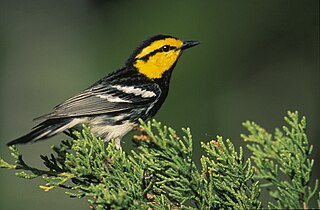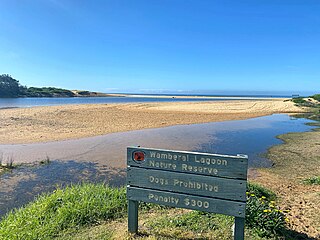
The golden-cheeked warbler is an endangered species of bird that breeds in Central Texas, from Palo Pinto County southwestward along the eastern and southern edge of the Edwards Plateau to Kinney County. The golden-cheeked warbler is the only bird species with a breeding range endemic to Texas.
The Matlacha Pass National Wildlife Refuge is part of the United States National Wildlife Refuge System, located within the Matlacha Pass estuary, approximately 8 miles northwest of Fort Myers, Florida. The 538 acre (2.2 km2) refuge was established on September 26, 1908. The islands were established as a "preserve and breeding ground for native birds" by President Theodore Roosevelt. It is administered as part of the J. N. "Ding" Darling National Wildlife Refuge Complex.
Santa Ana National Wildlife Refuge is a 2,088-acre (8.45 km2) National Wildlife Refuge situated along the banks of the Rio Grande, south of Alamo in the Lower Rio Grande Valley, in Hidalgo County, South Texas.

Lampsilis bracteata, also known as the Texas fatmucket, is a species of freshwater mussel, an aquatic bivalve mollusk in the family Unionidae, the river mussels.

Quadrula is a genus of freshwater mussels, aquatic bivalve mollusks in the family Unionidae native to rivers of the American Midwest and mid-south. All have thick nacreous shells with well-developed hinge teeth, many also with external shell sculpturing of nodules or lumps.
Rotundaria couchiana, the Rio Grande monkeyface, is a species of freshwater mussel. It is native to Chihuahua, Mexico and New Mexico and Texas in the United States.

The winged mapleleaf, also known as false mapleleaf, or hickory nut shell, and with the scientific name Quadrula fragosa, is a species of freshwater mussel. It is an aquatic bivalve mollusk in the family Unionidae, the river mussels. It is endemic to the United States.
Rotundaria houstonensis, the smooth pimpleback, is a species of freshwater mussel native to the United States. It is endemic to the Colorado and Brazos River drainages in Texas.

Theliderma intermedia, the Cumberland monkeyface pearly mussel or Cumberland monkeyface, is a species of freshwater mussel in the family Unionidae, the river mussels. This aquatic bivalve mollusk is native to Tennessee and Virginia in the United States. Historically widespread in the upper Tennessee River system, it populations have been reduced by habitat destruction and pollution. It now only occurs in two tributaries: the Duck and Powell Rivers. It is a federally listed endangered species.

Quadrula quadrula, the mapleleaf, is a species of freshwater mussel, an aquatic bivalve mollusk in the family Unionidae, the river mussels.

An endangered species is a species that is very likely to become extinct in the near future, either worldwide or in a particular political jurisdiction. Endangered species may be at risk due to factors such as habitat loss, poaching and invasive species. The International Union for Conservation of Nature (IUCN) Red List lists the global conservation status of many species, and various other agencies assess the status of species within particular areas. Many nations have laws that protect conservation-reliant species which, for example, forbid hunting, restrict land development, or create protected areas. Some endangered species are the target of extensive conservation efforts such as captive breeding and habitat restoration.

The environment of Iowa has been heavily affected by agricultural production since it became a U.S. state in 1846. However, there remain natural areas in Iowa that reflect a wide varieties of environmental niches.

Wamberal Lagoon, an intermittently closed intermediate saline coastal lagoon, is located on the Central Coast region of New South Wales, Australia. Wamberal Lagoon is located between the beachside settlements of Forresters Beach and Wamberal, and adjacent to the east coast, about 87 kilometres (54 mi) north of Sydney.
The sculptured pigtoe is a species of freshwater mussel native to the United States. It is endemic to the Apalachicola and Ochlockonee River systems in the states of Alabama, Florida, and Georgia.
Rotundaria refulgens, the purple pimpleback, is a species of freshwater mussel.
Rotundaria succissa is a species of bivalve in the family Unionidae.

Theliderma tuberosa, the rough rockshell, is a species of freshwater mussel. It is an aquatic bivalve mollusk in the family Unionidae, the river mussels. It has sometimes been treated as a variety or big-river ecotype of Theliderma metanevra, due to only having slight shell differences.

The Threatened Species Conservation Act 1995 (TSC Act) was enacted by the Parliament of New South Wales in 1995 to protect threatened species, populations and ecological communities in NSW. In 2016 it was replaced by the Biodiversity Conservation Act 2016. These acts form the basis and the mechanisms in NSW by which species, populations and ecological communities are declared endangered, vulnerable or critically endangered, and under which people and corporations are prosecuted for destruction of habitat sheltering such species, populations or communities.











